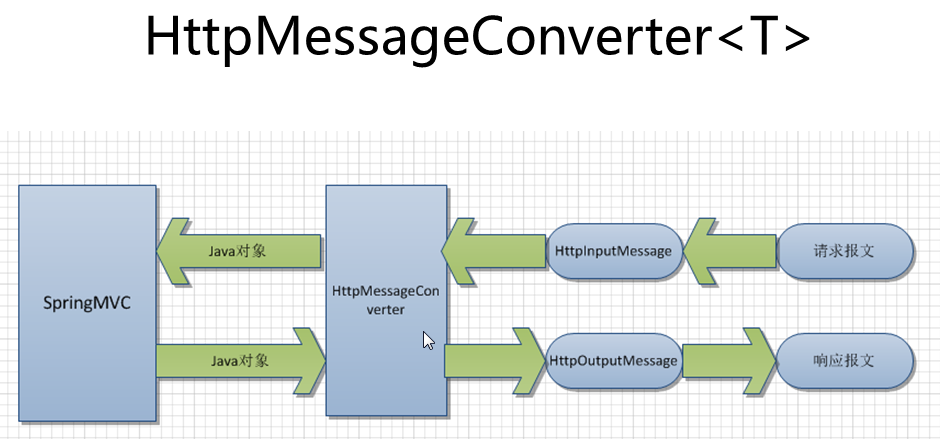SpringMvc返回JSON的工作原理。
一:导入jar包。然后在springmvc.xml中配置上这么一句话
<!-- 能支持springmvc更高级的一些功能,JSR303校验,快捷的ajax,处理JSON数据。映射动态请求 -->
<mvc:annotation-driven/>
<mvc:annotation-driven /> 会自动注册DefaultAnnotationHandlerMapping与AnnotationMethodHandlerAdapter 两个bean,是spring MVC为@Controllers分发请求所必须的。
并提供了:数据绑定支持,@NumberFormatannotation支持,@DateTimeFormat支持,@Valid支持,读写XML的支持(JAXB),读写JSON的支持(Jackson)。
二:在方法中前面加上这么一个注解:
@ResponseBody
return返回的就是一个JSON的对象。而不是去跳转到页面上。
原理:使用HtppMessageConverter这个类。
这个类负责将请求信息转换成一个对象。将对象输出为响应信息。

简介:
@RequestBody
作用:
i) 该注解用于读取Request请求的body部分数据,使用系统默认配置的HttpMessageConverter进行解析,然后把相应的数据绑定到要返回的对象上;
ii) 再把HttpMessageConverter返回的对象数据绑定到 controller中方法的参数上。
使用时机:
A) GET、POST方式提时, 根据request header Content-Type的值来判断:
- application/x-www-form-urlencoded, 可选(即非必须,因为这种情况的数据@RequestParam, @ModelAttribute也可以处理,当然@RequestBody也能处理);
- multipart/form-data, 不能处理(即使用@RequestBody不能处理这种格式的数据);
- 其他格式, 必须(其他格式包括application/json, application/xml等。这些格式的数据,必须使用@RequestBody来处理);
B) PUT方式提交时, 根据request header Content-Type的值来判断:
- application/x-www-form-urlencoded, 必须;
- multipart/form-data, 不能处理;
- 其他格式, 必须;
说明:request的body部分的数据编码格式由header部分的Content-Type指定;
@ResponseBody
作用:
该注解用于将Controller的方法返回的对象,通过适当的HttpMessageConverter转换为指定格式后,写入到Response对象的body数据区。
使用时机:
返回的数据不是html标签的页面,而是其他某种格式的数据时(如json、xml等)使用;
<span style="font-family:Microsoft YaHei;">/**
* Strategy interface that specifies a converter that can convert from and to HTTP requests and responses.
*
* @author Arjen Poutsma
* @author Juergen Hoeller
* @since 3.0
*/
public interface HttpMessageConverter<T> { /**
* Indicates whether the given class can be read by this converter.
* @param clazz the class to test for readability
* @param mediaType the media type to read, can be {@code null} if not specified.
* Typically the value of a {@code Content-Type} header.
* @return {@code true} if readable; {@code false} otherwise
*/
boolean canRead(Class<?> clazz, MediaType mediaType); /**
* Indicates whether the given class can be written by this converter.
* @param clazz the class to test for writability
* @param mediaType the media type to write, can be {@code null} if not specified.
* Typically the value of an {@code Accept} header.
* @return {@code true} if writable; {@code false} otherwise
*/
boolean canWrite(Class<?> clazz, MediaType mediaType); /**
* Return the list of {@link MediaType} objects supported by this converter.
* @return the list of supported media types
*/
List<MediaType> getSupportedMediaTypes(); /**
* Read an object of the given type form the given input message, and returns it.
* @param clazz the type of object to return. This type must have previously been passed to the
* {@link #canRead canRead} method of this interface, which must have returned {@code true}.
* @param inputMessage the HTTP input message to read from
* @return the converted object
* @throws IOException in case of I/O errors
* @throws HttpMessageNotReadableException in case of conversion errors
*/
T read(Class<? extends T> clazz, HttpInputMessage inputMessage)
throws IOException, HttpMessageNotReadableException; /**
* Write an given object to the given output message.
* @param t the object to write to the output message. The type of this object must have previously been
* passed to the {@link #canWrite canWrite} method of this interface, which must have returned {@code true}.
* @param contentType the content type to use when writing. May be {@code null} to indicate that the
* default content type of the converter must be used. If not {@code null}, this media type must have
* previously been passed to the {@link #canWrite canWrite} method of this interface, which must have
* returned {@code true}.
* @param outputMessage the message to write to
* @throws IOException in case of I/O errors
* @throws HttpMessageNotWritableException in case of conversion errors
*/
void write(T t, MediaType contentType, HttpOutputMessage outputMessage)
throws IOException, HttpMessageNotWritableException; }
</span>
该接口定义了四个方法,分别是读取数据时的 canRead(), read() 和 写入数据时的canWrite(), write()方法。
在使用 <mvc:annotation-driven />标签配置时,默认配置了RequestMappingHandlerAdapter(注意是RequestMappingHandlerAdapter不是AnnotationMethodHandlerAdapter,详情查看Spring 3.1 document “16.14 Configuring Spring MVC”章节),并为他配置了一下默认的HttpMessageConverter:
ByteArrayHttpMessageConverter converts byte arrays.
StringHttpMessageConverter converts strings.
ResourceHttpMessageConverter converts to/from org.springframework.core.io.Resource for all media types.
SourceHttpMessageConverter converts to/from a javax.xml.transform.Source.
FormHttpMessageConverter converts form data to/from a MultiValueMap<String, String>.
Jaxb2RootElementHttpMessageConverter converts Java objects to/from XML — added if JAXB2 is present on the classpath.
MappingJacksonHttpMessageConverter converts to/from JSON — added if Jackson is present on the classpath.
AtomFeedHttpMessageConverter converts Atom feeds — added if Rome is present on the classpath.
RssChannelHttpMessageConverter converts RSS feeds — added if Rome is present on the classpath.
ByteArrayHttpMessageConverter: 负责读取二进制格式的数据和写出二进制格式的数据;
StringHttpMessageConverter: 负责读取字符串格式的数据和写出二进制格式的数据;
ResourceHttpMessageConverter:负责读取资源文件和写出资源文件数据;
FormHttpMessageConverter: 负责读取form提交的数据(能读取的数据格式为 application/x-www-form-urlencoded,不能读取multipart/form-data格式数据);负责写入application/x-www-from-urlencoded和multipart/form-data格式的数据;
MappingJacksonHttpMessageConverter: 负责读取和写入json格式的数据;
SouceHttpMessageConverter: 负责读取和写入 xml 中javax.xml.transform.Source定义的数据;
Jaxb2RootElementHttpMessageConverter: 负责读取和写入xml 标签格式的数据;
AtomFeedHttpMessageConverter: 负责读取和写入Atom格式的数据;
RssChannelHttpMessageConverter: 负责读取和写入RSS格式的数据;
当使用@RequestBody和@ResponseBody注解时,RequestMappingHandlerAdapter就使用它们来进行读取或者写入相应格式的数据。
HttpMessageConverter匹配过程:
@RequestBody注解时: 根据Request对象header部分的Content-Type类型,逐一匹配合适的HttpMessageConverter来读取数据;
spring 3.1源代码如下:
private Object readWithMessageConverters(MethodParameter methodParam, HttpInputMessage inputMessage, Class paramType)
throws Exception { MediaType contentType = inputMessage.getHeaders().getContentType();
if (contentType == null) {
StringBuilder builder = new StringBuilder(ClassUtils.getShortName(methodParam.getParameterType()));
String paramName = methodParam.getParameterName();
if (paramName != null) {
builder.append(' ');
builder.append(paramName);
}
throw new HttpMediaTypeNotSupportedException(
"Cannot extract parameter (" + builder.toString() + "): no Content-Type found");
} List<MediaType> allSupportedMediaTypes = new ArrayList<MediaType>();
if (this.messageConverters != null) {
for (HttpMessageConverter<?> messageConverter : this.messageConverters) {
allSupportedMediaTypes.addAll(messageConverter.getSupportedMediaTypes());
if (messageConverter.canRead(paramType, contentType)) {
if (logger.isDebugEnabled()) {
logger.debug("Reading [" + paramType.getName() + "] as \"" + contentType
+"\" using [" + messageConverter + "]");
}
return messageConverter.read(paramType, inputMessage);
}
}
}
throw new HttpMediaTypeNotSupportedException(contentType, allSupportedMediaTypes);
}
@ResponseBody注解时: 根据Request对象header部分的Accept属性(逗号分隔),逐一按accept中的类型,去遍历找到能处理的HttpMessageConverter;
源代码如下:
private void writeWithMessageConverters(Object returnValue,
HttpInputMessage inputMessage, HttpOutputMessage outputMessage)
throws IOException, HttpMediaTypeNotAcceptableException {
List<MediaType> acceptedMediaTypes = inputMessage.getHeaders().getAccept();
if (acceptedMediaTypes.isEmpty()) {
acceptedMediaTypes = Collections.singletonList(MediaType.ALL);
}
MediaType.sortByQualityValue(acceptedMediaTypes);
Class<?> returnValueType = returnValue.getClass();
List<MediaType> allSupportedMediaTypes = new ArrayList<MediaType>();
if (getMessageConverters() != null) {
for (MediaType acceptedMediaType : acceptedMediaTypes) {
for (HttpMessageConverter messageConverter : getMessageConverters()) {
if (messageConverter.canWrite(returnValueType, acceptedMediaType)) {
messageConverter.write(returnValue, acceptedMediaType, outputMessage);
if (logger.isDebugEnabled()) {
MediaType contentType = outputMessage.getHeaders().getContentType();
if (contentType == null) {
contentType = acceptedMediaType;
}
logger.debug("Written [" + returnValue + "] as \"" + contentType +
"\" using [" + messageConverter + "]");
}
this.responseArgumentUsed = true;
return;
}
}
}
for (HttpMessageConverter messageConverter : messageConverters) {
allSupportedMediaTypes.addAll(messageConverter.getSupportedMediaTypes());
}
}
throw new HttpMediaTypeNotAcceptableException(allSupportedMediaTypes);
}
最新文章
- volatile用法
- Servlet3.0中Servlet的使用
- 单选框的回显c:if
- linux卸载挂载点显示device is busy
- 关于微信网页调用js-sdk相关接口注意事项目(一级域名与二级域名互相干扰!!!)
- CAP原则(CAP定理)
- unity 脚本(自定义组件)的事件触发关系
- Android让你的Toast变得炫酷
- SQL Server 分区表的创建方法与管理
- 关于C#开发 windows服务进程
- python --- 插入排序算法
- C语言面试基础知识整理
- [Zephyr] 1、在linux上安装Zephyr-OS并跑DEMO
- applet jre冲突问题
- 为什么分布式数据库中不使用uuid作为主键?
- [20171130]关于rman备份疑问.txt
- Linux内核入门(六)—— __attribute__ 机制【转】
- ajax jqplot ssh实现图表的持续更新
- bzoj千题计划119:bzoj1029: [JSOI2007]建筑抢修
- 《Java程序设计》第九周学习总结 20165218 2017-2018-2